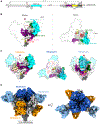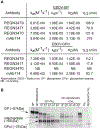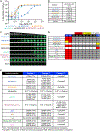Structure of the Inmazeb cocktail and resistance to Ebola virus escape
- PMID: 36708708
- PMCID: PMC10375381
- DOI: 10.1016/j.chom.2023.01.002
Structure of the Inmazeb cocktail and resistance to Ebola virus escape
Abstract
Monoclonal antibodies can provide important pre- or post-exposure protection against infectious disease for those not yet vaccinated or in individuals that fail to mount a protective immune response after vaccination. Inmazeb (REGN-EB3), a three-antibody cocktail against Ebola virus, lessened disease and improved survival in a controlled trial. Here, we present the cryo-EM structure at 3.1 Å of the Ebola virus glycoprotein, determined without symmetry averaging, in a simultaneous complex with the antibodies in the Inmazeb cocktail. This structure allows the modeling of previously disordered portions of the glycoprotein glycan cap, maps the non-overlapping epitopes of Inmazeb, and illuminates the basis for complementary activities and residues critical for resistance to escape by these and other clinically relevant antibodies. We further provide direct evidence that Inmazeb protects against the rapid emergence of escape mutants, whereas monotherapies even against conserved epitopes do not, supporting the benefit of a cocktail versus a monotherapy approach.
Keywords: Ebola; antiviral; cocktail; cryo-EM; escape; structure; therapeutics.
Copyright © 2023 The Authors. Published by Elsevier Inc. All rights reserved.
Conflict of interest statement
Declaration of interests The Regeneron employees have stock and/or options in the company. C.A.K. is an officer of the company. The antibodies are patented: WO/2016/123019.
Figures






References
-
- Pratt C. (2020). Two Ebola virus variants circulating during the 2020 Equateur Province outbreak. https://virological.org/t/two-ebola-virus-variants-circulating-during-th....
-
- Center for Drug Evaluation and Research (2020). FDA approves treatment for Ebola virus (U.S. Food and Drug Administration; ). https://www.fda.gov/drugs/news-events-human-drugs/fda-approves-treatment....
MeSH terms
Substances
Grants and funding
LinkOut - more resources
Full Text Sources
Medical
Miscellaneous

